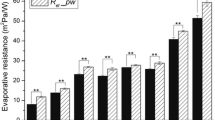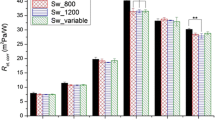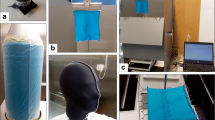Abstract
Clothing evaporative resistance is one of the inherent factors that impede heat exchange by sweating evaporation. It is widely used as a basic input in physiological heat strain models. Previous studies showed a large variability in clothing evaporative resistance both at intra-laboratory and inter-laboratory testing. The errors in evaporative resistance may cause severe problems in the determination of heat stress level of the wearers. In this paper, the effect of temperature difference between the manikin nude surface and wet textile skin surface on clothing evaporative resistance was investigated by both theoretical analysis and thermal manikin measurements. It was found that the temperature difference between the skin surface and the manikin nude surface could lead to an error of up to 35.9% in evaporative resistance of the boundary air layer. Similarly, this temperature difference could also introduce an error of up to 23.7% in the real clothing total evaporative resistance (R et_real < 0.1287 kPa m2/W). Finally, it is evident that one major error in the calculation of evaporative resistance comes from the use of the manikin surface temperature instead of the wet textile fabric skin temperature.


Similar content being viewed by others
References
ASTM (2009) ASTM F1868 standard test method for thermal and evaporative resistance of clothing materials using a sweating hot plate. American Society for Testing and Materials, Philadelphia, PA
ASTM (2010) ASTM F2370 standard test method for measuring the evaporative resistance of clothing using a sweating manikin. American Society for Testing and Materials, Philadelphia, PA
Caravello V, McCullough EA, Ashley CD, Bernard TE (2007) Apparent evaporative resistance at critical conditions for five clothing ensembles. Eur J Appl Physiol 104:361–367. doi:10.1007/s00421-007-0655-9
Fan J, Chen YS (2002) Measurement of clothing thermal insulation and moisture vapour resistance using a novel perspiring fabric thermal manikin. Meas Sci Technol 13:1115–1123. doi:10.1088/0957-0233/13/7/320
Fiala D, Lomas KJ, Stohrer M (1999) Computer prediction of human thermoregulatory and temperature responses to a wide range of environmental conditions. Int J Biometeorol 45:143–159. doi:10.1007/s004840100099
Gao C, Holmér I (2006) Initial, transient and steady state evaporative resistance of impermeable protective clothing. Proceedings of the Sixth International Meeting on Thermal Manikin and Modeling, Hong Kong, Oct.2006, pp 253–261
Gonzalez R, McLellan T, Withey W, Chang S, Pandolf K (1997) Heat strain models applicable for protective clothing system: comparison of core temperature response. J Appl Physiol 83:1017–1032
Havenith G, Richards M, Wang X, Bröde P, Candas V, den Hartog E, Holmér I, Kuklane K, Meinander, Nocker W (2008) Use of clothing vapour resistance values derived from manikin mass losses or isothermal heat losses may cause severe under and over estimation of heat stress. Proceedings of the Seventh International Meeting on Thermal Manikin and Modeling, Portugal
Holmér I, Elnäs S (1981) Physiological evaluation of the resistance to evaporative heat transfer by clothing. Ergonomics 24:63–74
Huang J (2007a) Assessment of clothing effects in thermal comfort standards: a review. J Test Eval 35:455–462. doi:10.1520/JTE100707
Huang J (2007b) Prediction of air temperature for thermal comfort of people in outdoor environments. Int J Biometeorol 51:375–382. doi:10.1007/s00484-006-0083-2
ISO 11092 (1993) Textiles–Physiological effects–Measurement of thermal and water vapour resistance under steady-state conditions (Sweating guarded hotplate test). International Organization for standardization, Geneva, Switzerland
ISO 7933 (2004) Ergonomics of the thermal environment–Analytical determination and interpretation of thermal stress using calculation of the required heat strain. International Organization for standardization, Geneva, Switzerland
Kellett EM, Weller AS, Bentley M, Withey WR (2001) Application of a computer model to set heat strain threshold limit values: evaluation during a simulated army basic combat fitness test. Proceedings of RTO HFM Symposium on “Blowing Hot and Cold: Protecting Against Climatic Extremes”, Dresden, Germany, pp 1–5
Malchaire JBM (2006) Occupational heat stress assessment by the predicted heat strain model. Ind Health 44:380–387
McCullough EA (2001) Interlaboratory study of sweating thermal manikins. Proceedings of the Fourth International Meeting on Thermal Manikins. EMPA, Switzerland, pp 1–4
McCullough EA, Kenney WL (2003) Thermal insulation and evaporativeresistance of football uniforms. Med Sci Sports Exercise 35:832–837
McCullough EA, Jones BW, Tamura T (1989) A data base for determining the evaporative resistance of clothing. ASHRAE Trans 95:316–328
Nilsson H (2004) Comfort climate evaluation with thermal manikin methods and computer simulation models. PhD dissertation, Royal Institute of Technology, Stockholm
Parsons KC (2003) Human thermal environments: the effects of hot, moderate and cold environments on human health, comfort and performance. Taylor & Francis, London
Richards MGM, McCullough EA (2005) Revised Interlaboratory study of sweating thermal manikins including results from the sweating agile thermal manikin. J ASTM Int 2:1–13. doi:10.1520/JAI12109
Ross KA (2005) Evaluation of an instrumented sweating manikin for predicting heat stress in firefighters’ turnout ensembles. Master dissertation, North Carolina State University, NC
Wang F, Gao C, Kuklane K, Holmér I (2009) A study on evaporative resistances of two skins design for thermal manikin ‘Tore’ under different environmental conditions. J Fiber Bioeng Inform 1:301–305. doi:10.3993/jfbi03200908
Wang F, Kuklane K, Gao C, Holmér I (2010) The development and validation of empirical equations to predict sweating skin surface temperature for thermal manikins. J Therm Biol 35:197–203. doi:10.1016/j.jtherbio.2010.03.004
Acknowledgements
This study was financially supported by Taiga AB in Varberg of Sweden. We are grateful to Scott C. Sheridan (the editor) and two anonymous reviewers for helpful comments.
Conflict of interest
The authors declare no conflict of interest.
Author information
Authors and Affiliations
Corresponding author
Additional information
An erratum to this article can be found at http://dx.doi.org/10.1007/s00484-011-0512-8
Rights and permissions
About this article
Cite this article
Wang, F., Kuklane, K., Gao, C. et al. Effect of temperature difference between manikin and wet fabric skin surfaces on clothing evaporative resistance: how much error is there?. Int J Biometeorol 56, 177–182 (2012). https://doi.org/10.1007/s00484-011-0411-z
Received:
Revised:
Accepted:
Published:
Issue Date:
DOI: https://doi.org/10.1007/s00484-011-0411-z




